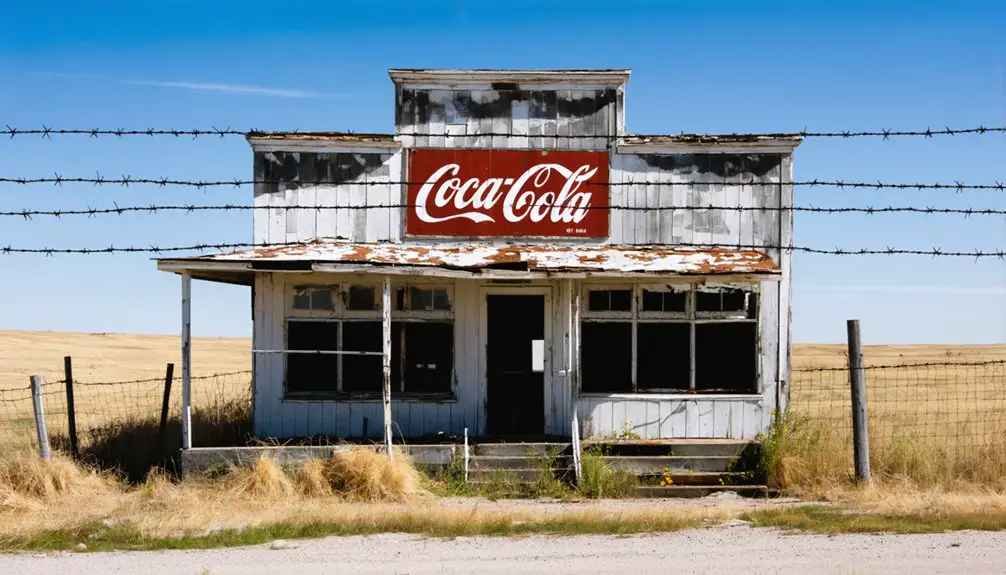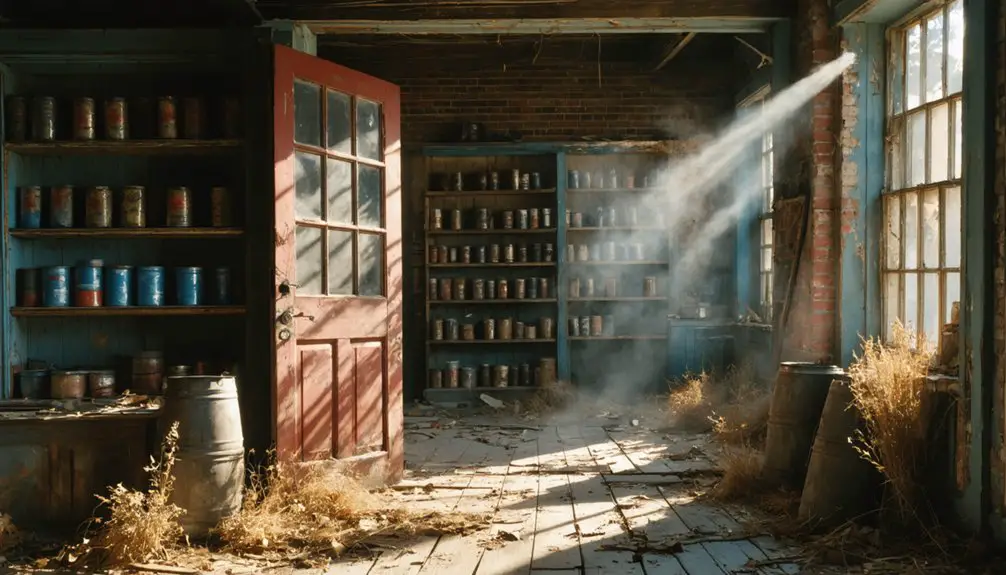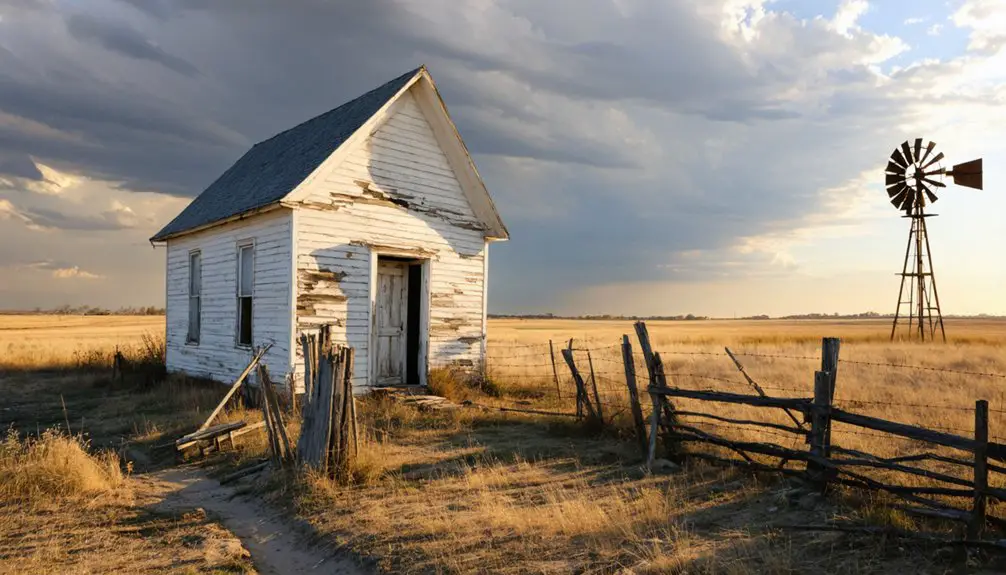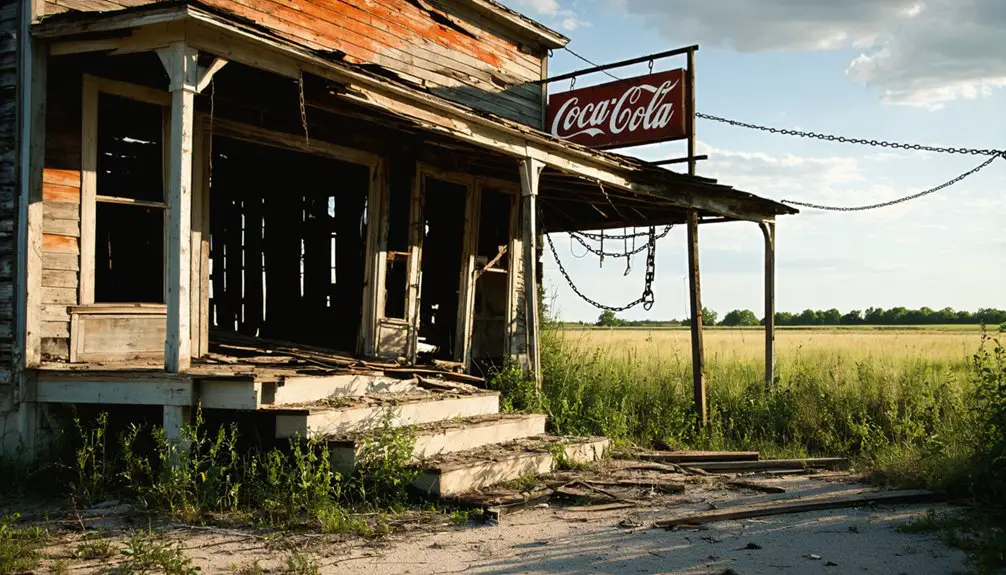You’ll discover Frazer along Bitter Creek, established in 1885 as a stage stop known as “Buttermilk Station” for its invigorating dairy offerings to passing cowboys. This Oklahoma Territory settlement, complete with a post office and school, thrived until June 4, 1891, when catastrophic flooding forced residents to relocate 2.5 miles east to higher ground. Their new settlement became Altus, while Frazer’s remnants and cemetery hold fascinating tales of frontier persistence and adaptation.
Key Takeaways
- Frazer was established in 1885 as a stage stop along Bitter Creek, known for providing buttermilk to cowboys on the Great Western Trail.
- The settlement became famous as “Buttermilk Station” with a post office and subscription school serving approximately fifty early settlers.
- A catastrophic flood in 1891 destroyed the entire settlement, forcing residents to relocate 2.5 miles east to establish Altus.
- The original Frazer site is now a ghost town, with only the historic Frazer Cemetery remaining on the National Register of Historic Places.
- Archaeological evidence of the ghost town includes foundation ruins and road remnants near Bitter Creek from the 1891 flood.
Origins Along Bitter Creek
Along the banks of Bitter Creek in what was then Greer County, Texas territory, the settlement of Frazer emerged in 1885 as an important stage stop on the Mobeete Trail.
You’ll find Bitter Creek’s significance woven into the fabric of this frontier outpost, where roughly fifty early settlers carved out their lives alongside cowboys driving cattle on the Great Western Trail.
The establishment of a post office in February 1886 and a subscription school marked Frazer’s growth from a simple watering stop to a developing community.
Early settler experiences centered around the creek’s essential resources, with John McClearan’s dugout earning the nickname “Buttermilk Station” among trail-weary cowboys.
Trail-weary cowboys found respite at McClearan’s dugout, a humble shelter known affectionately as Buttermilk Station along Bitter Creek.
Like many abandoned mining towns in Oklahoma’s history, this strategic location supported not only local agriculture but served as a critical lifeline for transportation and communication in the untamed southwestern territory.
The town’s fate changed dramatically when a devastating flood in 1891 washed away the entire settlement, forcing residents to relocate to higher ground in nearby Altus.
The Buttermilk Station Legacy
You’ll find that Frazer’s earliest claim to fame came from its popular nickname “Buttermilk Station,” earned when local residents offered cold buttermilk to passing cowboys along the Great Western Trail.
The post office established by John McClearen in 1886 made the station an important destination for cowboys seeking mail and refreshments. As word spread among cattle drivers, the McClearan dugout became a sought-after rest stop where cowboys could count on this invigorating dairy drink during their long journeys north.
The tradition of offering buttermilk to travelers transformed Frazer into a notable trading hub where cowboys and locals established lasting relationships through this simple act of frontier hospitality. In 1891, the townspeople were forced to abandon Frazer when severe flooding devastated the area, leading them to establish the new community of Altus.
Cowboys’ Favorite Rest Stop
When cowboys drove their cattle along the Great Western Trail in the 1880s, they discovered an oasis of hospitality in Frazer, Oklahoma, which quickly earned the nickname “Buttermilk Station.”
This welcoming stop near the Salt Fork of the Red River became legendary among cattle drivers, thanks to the McClearen family’s practice of offering cold buttermilk from their well dugout. Modern visitors attempting to view historical sites should ensure JavaScript is enabled in their browsers to access interactive maps and location details.
You’ll find that Frazer wasn’t just another waypoint – it embodied the spirit of cowboy camaraderie that defined the American frontier.
The post office, established in 1886, gave cowboys a chance to collect mail while enjoying the town’s famous buttermilk hospitality.
This simple rest stop played a vital role in supporting the cattle-driving economy, creating a lasting legacy that persisted even after the town relocated to higher ground as Altus in 1891.
A devastating flash flood on June 4, 1891, forced residents to abandon their original settlement and establish a new community on elevated terrain.
Local Dairy Trading Hub
The simple act of offering buttermilk to weary cowboys transformed Frazer into a thriving dairy trading post along the Great Western Trail.
At the McClearen family’s dugout, you’d find cowboys gathering to purchase not just the signature cold buttermilk kept fresh in the well, but also other essential supplies for their journey.
This dairy economy became the heartbeat of early Frazer, where cowboy culture and settler commerce intersected.
The McClearen’s natural refrigeration method, using their well to keep dairy products cool in the harsh Oklahoma climate, created a reliable trading hub.
While the settlement would later relocate and become Altus, Frazer’s reputation as “Buttermilk Station” endures as a symbol of how frontier ingenuity and hospitality could transform a simple refreshment stop into a crucial commercial center.
Life in Early Frazer Settlement
Life in early Frazer settlement revolved around its strategic position near Bitter Creek and the Great Western Cattle Trail. You’d find about fifty settlers, mostly cattlemen and their families, building their lives around the rhythms of frontier ranching. Like many frontier settlements that emerged after the Oklahoma Land Rush, Frazer developed as pioneers sought new opportunities in the territory.
Community dynamics centered on key gathering spots like the John McClearan dugout, where you could count on a cold glass of buttermilk after a long cattle drive. The settlement’s frontier education system operated through a subscription school, where local children learned their lessons while adapting to the challenges of frontier life. A devastating flood in 1891 forced residents to evacuate their homes and seek safety in higher ground.
You’d witness daily activities shaped by the natural resources of Bitter Creek, crucial for survival in this outpost. The post office and stage stand served as essential connections to the outside world, keeping settlers linked to civilization despite their remote location.
The Great Flood of 1891
On June 4, 1891, devastating floodwaters from Bitter Creek engulfed the entire Frazer settlement, forever altering the community’s destiny. Heavy rains had caused the creek and surrounding streams to swell rapidly, forcing residents to wake up to water inundating their homes and lands. Similar to the catastrophic losses faced by farmers across the Mississippi River valley that same spring, the flood aftermath left Frazer’s infrastructure in ruins, making reconstruction impossible at the original site. The town had served as an important stage stop location before its destruction.
Displaying remarkable community resilience, residents chose to relocate their entire settlement two and a half miles east to higher ground. You’ll find that this strategic move led to the establishment of Altus, named from the Latin word for “high.”
The flooding marked a pivotal moment in Old Greer County’s history, transforming a vulnerable frontier settlement into what would become a thriving regional hub.
Relocation and Rise of Altus

After the devastating 1891 flood, you’ll find that Frazer’s residents made the prudent decision to relocate their community 2.5 miles east to higher ground, establishing what would become Altus.
The new settlement’s name, derived from the Latin word for “high,” reflected both its elevated location and the community’s aspirations for growth.
Moving to Higher Ground
When a devastating flash flood swept through Frazer on June 4, 1891, the town’s 50 residents made the essential decision to relocate their community 2.5 miles east to higher ground.
Their flood preparedness strategy centered on choosing an elevated site that would protect them from future water damage along Bitter Creek.
You’ll find that community resilience shaped this bold move, as residents united behind W. R. Baucum’s proposal to rename their settlement Altus, meaning “high” in Latin.
Though briefly known as Leger from 1901-1904, the town maintained its identity as Altus, symbolizing their triumph over environmental challenges.
This strategic relocation proved vital, as it provided the foundation for Altus’s future growth, including its selection as Jackson County seat in 1908 and its development into a thriving regional hub.
Building County Leadership
The relocation of Frazer marked the beginning of concentrated leadership efforts that would transform a small settlement into Jackson County’s governmental hub. Through community organization, W.R. Baucum and other leaders strategically renamed the town “Altus,” positioning it for growth on higher ground 2.5 miles east of the original site.
You’ll find that leadership evolution accelerated between 1901 and 1908, culminating in Altus’s decisive victory as county seat over Olustee.
The construction of the Jackson County Courthouse in 1910 cemented the town’s administrative authority. Railroad connections brought by the Kansas City, Mexico and Orient Railway fostered economic expansion, helping grow the population from 1,927 to 8,349 between 1907 and 1930.
This period established Altus as the region’s primary agricultural trade center, equipped with cotton gins and wholesale businesses.
From Creek-side to County Seat
Life along Bitter Creek marked Frazer’s humble beginnings as a small settlement of fifty souls in Old Greer County, Texas. You’d have found cowboys stopping at John McClearan’s dugout for cold buttermilk, earning it the nickname “Buttermilk Station.”
Settlement challenges came to a head on June 4, 1891, when a devastating flash flood nearly destroyed the town. Showing remarkable community resilience, residents relocated two and a half miles east to higher ground. W.R. Baucum suggested naming the new site “Altus,” meaning “high” in Latin.
The move proved transformative – from a modest creek-side outpost, the town grew to 1,927 residents by 1907. Your ancestors’ determination paid off when Altus secured its position as Jackson County seat in 1908, garnering 2,077 votes and establishing itself as a regional hub.
Historical Landmarks and Remnants

Today, Frazer Cemetery stands as a solitary sentinel of Oklahoma’s frontier past, earning its place on the National Register of Historic Places through its preservation of early settler history.
You’ll find this landmark near Bitter Creek, where it remains one of the few tangible links to Frazer’s original settlement.
While the town’s buildings have largely vanished, archaeological evidence reveals fascinating glimpses of frontier life through foundation ruins and road remnants.
The 1891 flood forced residents to relocate to higher ground, leaving behind scattered structural clues of their earlier presence.
Cemetery preservation efforts have maintained burial records that reflect the community’s demographics from the 1880s onward.
Though most original structures were dismantled or decayed, careful surveys can still trace lot outlines and building footprints of this once-thriving settlement.
Impact on Regional Development
As Frazer’s decline mirrored broader patterns across Oklahoma’s frontier settlements, its abandonment markedly shaped regional development through economic ripple effects.
You’ll find that Frazer’s story exemplifies how transportation shifts and resource depletion triggered widespread economic decline across similar communities. When the 1891 flood forced residents to relocate to Altus, it accelerated a pattern of consolidation that would define Oklahoma’s development.
The town’s fate influenced regional growth by demonstrating the vulnerability of single-resource economies. While some communities showed remarkable community resilience by diversifying their economic base, Frazer’s inability to adapt led to its downfall.
The construction of new highways and rail lines bypassing these areas further isolated such settlements, concentrating development in better-connected urban centers where you’ll now find thriving populations.
Oklahoma’s Lost Communities

Throughout Oklahoma’s history, more than 2,000 communities have vanished into ghost town status, leaving behind fragments of the state’s frontier heritage.
You’ll find these lost communities scattered across the state, each telling a unique story of economic decline and cultural transformation. Ghost town preservation efforts have documented how these settlements emerged and faded, from liquor towns that vanished after statehood to mining communities that collapsed when resources ran dry.
- Boom towns like Picher transformed from bustling mining centers to toxic wastelands
- Native American trading posts like Boggy Depot became cultural crossroads before disappearing
- Railroad towns flourished and died as transportation routes shifted
- Prohibition eliminated dozens of pre-statehood liquor towns like Beer City
- Dam construction submerged entire communities, including Keystone and Appalachia
Frequently Asked Questions
What Crops Were Primarily Grown by Frazer’s Early Settlers?
You’d find a diversity of crops through early farming techniques: corn served as the main staple, while oats fed horses, sorghum provided livestock fodder, wheat became prominent later, and cotton supported commerce.
Are There Any Surviving Photographs of the Original Frazer Settlement?
Like footprints washed away by time, you won’t find any confirmed surviving photographs of the original settlement. Historic documentation relies on written accounts, with no definitive visual evidence currently discovered in archives.
What Happened to the Native American Populations in the Frazer Area?
You’ll find that Native displacement heavily impacted local tribes, with many Choctaw and Creek families, including the Fraziers, relocating to other parts of Oklahoma while maintaining cultural ties through mixed-blood leadership roles.
Did Any Original Frazer Buildings Survive the Relocation to Altus?
You won’t find any architectural remnants from original Frazer buildings – the relocation impacts were complete. When residents moved to Altus’s higher ground, they left their structures behind to decay or flood damage.
How Much Did Land Cost in Frazer During Its Brief Existence?
You’d find land values ranged from $1-5 per acre during Frazer’s existence, though exact records are sparse. Economic factors like flood risks and frontier conditions kept prices at settlement-era lows.
References
- https://en.wikipedia.org/wiki/List_of_ghost_towns_in_Oklahoma
- https://www.okhistory.org/publications/enc/entry?entry=GH002
- https://kids.kiddle.co/List_of_ghost_towns_in_Oklahoma
- http://nr2_shpo.okstate.edu/QueryResult.aspx?id=11000336
- https://www.okhistory.org/publications/enc/entry?entry=AL013
- https://www.ghosttowns.com/states/ok/frazer.html
- https://www.youtube.com/watch?v=5NI-cU4nQ6w
- https://www.altus.af.mil/About-Us/Fact-Sheets/Display/Article/352069/chronology-of-altus-air-force-base/
- https://frankbellizzi.blogspot.com/2025/05/pre-history-of-jackson-county-oklahoma-2.html
- https://www.altusok.gov/page/altus-history



